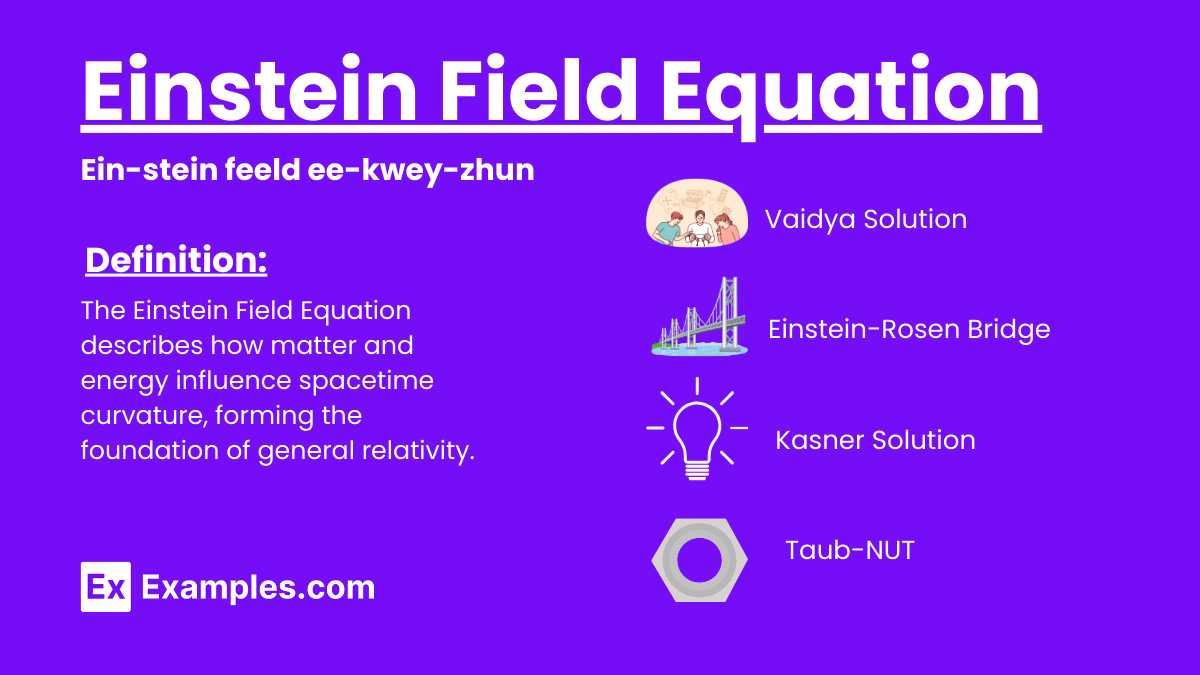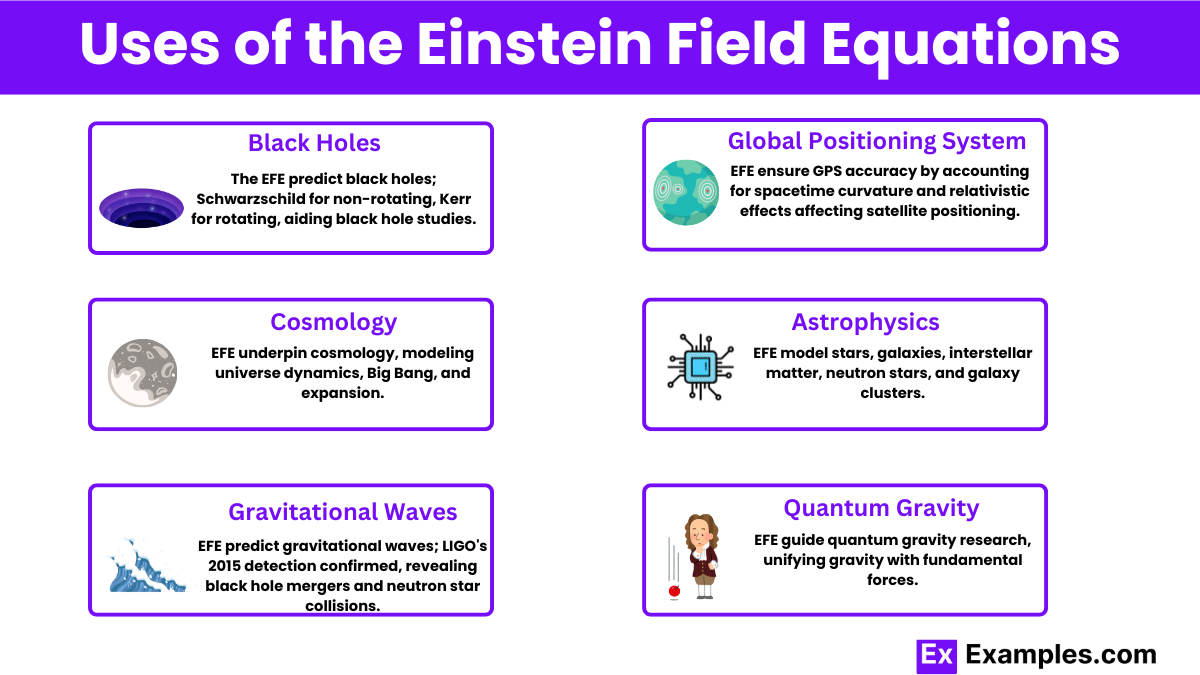What is the fundamental equation in Einstein's theory of General Relativity?
E = mc²
F = ma
Rμν - ½Rgμν + Λgμν = 8πGTμν
V = IR


The Einstein Field Equation (EFE), central to Einstein’s theory of general relativity, describes how matter and energy influence spacetime curvature. Formulated by Albert Einstein in 1915, the EFE is a set of ten interrelated differential equations. These equations express the relationship between the geometry of spacetime, represented by the Einstein tensor, and the distribution of matter within it, captured by the stress-energy tensor. By explaining gravitational phenomena as the warping of spacetime, the EFE revolutionized our understanding of gravity, providing the foundation for modern cosmology and astrophysics.
The Einstein Field Equation (EFE) is a cornerstone of Albert Einstein’s theory of general relativity. It mathematically describes how matter and energy in the universe shape the curvature of spacetime. The EFE is expressed as:
Gμν + Λgμν = 48πG/c⁴Tμν
where:
This equation shows that the curvature of spacetime (left side) is directly related to the energy and momentum of whatever matter and radiation are present (right side). The EFE underpins much of modern physics, including black holes, cosmology, and the expansion of the universe.
The Einstein Field Equations (EFE) derive from the need to generalize Newton’s law of gravitation in a manner consistent with the principles of general relativity. Here’s a step-by-step derivation:
The starting point is the Einstein-Hilbert action, which provides a functional whose variation gives the field equations. The action ( S ) is given by:
[ S =1/16πG ∫ (R−2Λ)√−gd⁴x+Sₘ
where:
To obtain the field equations, we vary the action with respect to the metric tensor ( g_{\mu\nu} ):
δS=1/16πG ∫ δ(−√gR−√2−gΛ)d⁴x + δSₘ = 0
The variation of the Ricci scalar ( R ) and the metric determinant ( g ) are given by:
δ(√−gR)=√−g(Rμν−1/2Rgμν)δgμν + gμνδRμν
However, the second term involving ( δRμν} ) can be handled using the Palatini identity, simplifying to:
δ(√−gR)=√−g(Rμν−1/2Rgμν)δgμν
The variation of the cosmological constant term is straightforward:
δ(−2Λ√−g)=−2Λ−gδgμνgμν
The variation of the matter action ( S_m ) with respect to the metric gives the stress-energy tensor ( T_{\mu\nu} ):
δSm = 1/2∫Tμνδgμν √−gd⁴x
Combining all the variations, we obtain:
1/16πG1∫√−g (Rμν−1/2Rgμν+Λgμν) δgμνd⁴x+1/2∫√−gTμνδgμνd⁴x=0]
Since ( δgμν ) is arbitrary, the integrand must vanish:
Rμν − 1/2Rgμν + Λgμν = 8πGTμν
Rewriting, we get the Einstein Field Equations:
Rμν−1/2Rgμν + Λgμν = cπG/c⁴Tμν
This derivation shows that the EFE balances the curvature of spacetime (left side) with the energy and momentum of matter and radiation (right side), encapsulating the fundamental idea of general relativity.
The Einstein Tensor, denoted as 𝐺𝜇𝜈Gμν, is a fundamental concept in Einstein’s theory of general relativity. It plays a crucial role in the Einstein Field Equations (EFE), which describe how matter and energy influence the curvature of spacetime.
𝐺𝜇𝜈 = 𝑅𝜇𝜈−1/2𝑅𝑔𝜇𝜈
where:
The stress-energy tensor, denoted as Tαβ, is a symmetric tensor used to describe the energy and momentum density of a physical system, including the gravitational field. It encapsulates how energy and momentum are distributed and how they flow through spacetime. The stress-energy tensor is defined as:
Tαβ = Tβa

The Einstein Field Equations (EFE) are fundamental to our understanding of gravity, spacetime, and the universe. Here are some key uses and applications:
Black Holes : The EFE predict the existence of black holes, regions where spacetime curvature becomes infinite. Solutions like the Schwarzschild solution describe non-rotating black holes, while the Kerr solution describes rotating black holes. These solutions have been instrumental in studying black hole properties and behavior.
Cosmology : The EFE form the foundation of modern cosmology. They describe the large-scale structure and dynamics of the universe. Key cosmological models, such as the Friedmann-Lemaître-Robertson-Walker (FLRW) metric, are solutions to the EFE that describe an expanding universe. These models help explain phenomena like the Big Bang, cosmic inflation, and the accelerated expansion of the universe driven by dark energy.
Gravitational Waves : The EFE predict the existence of gravitational waves, ripples in spacetime caused by accelerating masses. The first direct detection of gravitational waves by LIGO in 2015 confirmed this prediction, opening a new era in astronomy and providing insights into events like binary black hole mergers and neutron star collisions.
Global Positioning System (GPS) : The EFE are crucial for the accuracy of the GPS. The curvature of spacetime around Earth affects the passage of time. GPS satellites must account for both special and general relativistic effects to provide accurate positioning data.
Astrophysics : The EFE are used to understand the structure and evolution of stars, the dynamics of galaxies, and the behavior of interstellar and intergalactic matter. They help model phenomena like neutron stars, white dwarfs, and the dynamics of galaxy clusters.
Tests of General Relativity : The EFE provide a framework for testing general relativity. Observations of phenomena such as the perihelion precession of Mercury, the deflection of light by the sun (gravitational lensing), and time dilation in strong gravitational fields (as observed in the Pound-Rebka experiment) confirm the predictions made by the EFE.
Quantum Gravity : The EFE are a stepping stone toward developing a theory of quantum gravity. They provide insights into how gravity might be unified with the other fundamental forces and guide research in theories like string theory and loop quantum gravity.
Vaidya Solution : The Vaidya solution describes the spacetime around a radiating star. Unlike the static Schwarzschild solution, the Vaidya solution accounts for the emission or absorption of radiation, such as light or neutrinos. This solution is crucial for understanding the dynamics of stars undergoing significant changes in mass due to radiation and provides insights into the late stages of stellar evolution and phenomena like supernovae.
Taub-NUT Solution : The Taub-NUT solution extends the Schwarzschild and Kerr solutions by including a parameter that represents a form of “gravitational monopole” charge, known as the NUT parameter. This solution is interesting for its peculiar properties, such as the existence of closed timelike curves, which suggest the possibility of time travel within this theoretical framework. It offers insights into more exotic gravitational configurations and the potential for complex interactions in the gravitational field.
Bianchi Models : Bianchi models are solutions to the EFE that describe homogeneous but anisotropic universes. Unlike the FLRW metric, which assumes isotropy, Bianchi models allow for different expansion rates in different directions. These models are used to study the early universe’s anisotropies and provide a deeper understanding of how initial conditions may have evolved into the more isotropic universe we observe today.
Gödel Solution : The Gödel solution is a solution to the EFE that describes a rotating universe. This solution is notable because it allows for the existence of closed timelike curves, implying the possibility of time travel within this theoretical model. The Gödel solution challenges our understanding of causality and time in the context of general relativity and provides a unique perspective on the effects of rotation on the structure of spacetime.
Einstein-Rosen Bridge : The Einstein-Rosen bridge, commonly known as a wormhole, is a theoretical solution to the EFE that describes a tunnel-like structure connecting two separate points in spacetime. This solution, derived by Einstein and Nathan Rosen, suggests the possibility of shortcuts through spacetime, potentially enabling faster-than-light travel. While primarily a theoretical construct, wormholes have fascinated scientists and science fiction writers alike, offering intriguing possibilities for interstellar travel and communication.
Kasner Solution : The Kasner solution describes an anisotropic universe without matter, expanding differently along three spatial axes. It is a vacuum solution to the EFE and serves as a simplified model for understanding anisotropic expansion. The Kasner solution helps in studying the dynamics of the early universe and the behavior of spacetime near singularities, providing insights into the initial conditions of the Big Bang.
Tolman-Oppenheimer-Volkoff (TOV) Equation : The TOV equation is derived from the EFE and describes the structure of a spherically symmetric body in hydrostatic equilibrium, such as a neutron star. It balances the gravitational force against the internal pressure of the star. This equation is crucial for understanding the maximum mass and stability of neutron stars, predicting phenomena like neutron star collapse and the formation of black holes.
The EFE are crucial for understanding gravitational phenomena, predicting black holes, explaining the expansion of the universe, and providing a framework for modern cosmology and astrophysics.
The cosmological constant ΛΛ represents the energy density of empty space, or dark energy, which causes the accelerated expansion of the universe.
Solutions to the EFE, such as the Schwarzschild and Kerr solutions, describe the spacetime around black holes, predicting their properties and behavior, including event horizons and singularities.
The Kerr solution extends the Schwarzschild solution to rotating masses, describing the spacetime around a rotating black hole and predicting phenomena such as frame dragging and the ergosphere.
Gravitational waves are ripples in spacetime caused by accelerating masses, predicted by the EFE. They were first directly detected by LIGO in 2015.
The Gödel solution describes a rotating universe and allows for closed timelike curves, implying the possibility of time travel within this theoretical framework.
A wormhole, or Einstein-Rosen bridge, is a theoretical solution to the EFE describing a tunnel-like structure connecting two separate points in spacetime, potentially enabling faster-than-light travel.
Bianchi models are solutions to the EFE that describe homogeneous but anisotropic universes, allowing different expansion rates in different directions, used to study early universe anisotropies.
The Schwarzschild solution is a solution to the EFE that describes the gravitational field around a non-rotating, spherical mass. It predicts the existence of black holes.
The Einstein Field Equations (EFE) are a set of ten interrelated differential equations formulated by Albert Einstein in his theory of general relativity, describing how matter and energy influence the curvature of spacetime.
Text prompt
Add Tone
10 Examples of Public speaking
20 Examples of Gas lighting
What is the fundamental equation in Einstein's theory of General Relativity?
E = mc²
F = ma
Rμν - ½Rgμν + Λgμν = 8πGTμν
V = IR
In Einstein's Field Equation, what does Rμν represent?
Energy-momentum tensor
Ricci curvature tensor
Gravitational constant
Metric tensor
What is the term G in Einstein's Field Equation?
Gravitational constant
Gauge symmetry
Geometric factor
General covariance
What does the tensor Tμν represent in the field equation?
Ricci tensor
Energy-momentum tensor
Metric tensor
Electromagnetic tensor
In the equation, what role does the term Λgμν play?
Represents the electromagnetic field
Represents the cosmological constant
Represents the curvature of spacetime
Represents the gravitational potential
How does the term R in Einstein's equation contribute to the equation?
Total curvature scalar
Radius of curvature
Rotational matrix
Random variable
What fundamental principle is embodied by Einstein's Field Equations?
Principle of relativity
Conservation of energy
Equivalence principle
Newton’s third law
Which mathematical object in the field equations describes the shape of spacetime?
Metric tensor gμν
Stress tensor
Potential energy
Velocity vector
What does the constant 8πG in the field equation signify?
Relation between space and time
Scaling factor between geometry and matter
Electromagnetic force
Quantum correction
What does the term gμν indicate in the context of General Relativity?
Gravitational field strength
Metric tensor components
Ricci tensor components
Cosmological expansion rate
Before you leave, take our quick quiz to enhance your learning!

